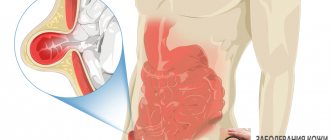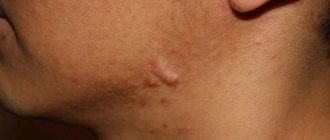When are brown spots in the groin area symptoms of a disease?
It happens that along with the appearance of pigmentation in the groin area, a person is also accompanied by various pains, a feeling of malaise and swelling, and it happens that they are discovered completely by accident, and it is not possible to determine how long they have been there. And if in the latter case we are more likely talking about a cosmetic defect that does not pose a threat to health, then in the former these are obvious symptoms of other, more serious diseases that require urgent diagnosis and treatment.
The main types of diseases whose symptoms may include age spots in the groin area:
- Erythrasma;
- Addison's disease;
- Tinea versicolor;
- Cancerous tumor of internal organs;
- Inguinal athlete's foot.
In Addison's disease, there is a disruption in the production of hormones, especially cortisol due to suppression of the adrenal glands, which leads to general disorder in the body and is accompanied by darkening of the nipples, armpits and the appearance of age spots in the groin area. Despite the fact that this disease is indeed very rare, according to world statistics, one in a hundred thousand people suffers from it, mostly women, but men are also susceptible to it.
In case of a cancerous tumor of internal organs - more often with the growth of a malignant neoplasm in the stomach, dark brown spots in the groin in men act as a signal fire. They have a velvety surface and are dense to the touch. In this case, you must definitely contact a gastroenterologist and undergo diagnostics to refute or confirm the presence of the disease. In women, such problems are more often accompanied by characteristic pain and ailments, and age spots appear less frequently.
Modern medicine classifies erythrasma as an infectious pseudomycosis transmitted by contact. With this disease, round, smooth brown spots appear in the groin, armpits, near the anus, on the thighs and other folds of the skin. If left untreated, the lesions begin to change color and increase in size until the extent of the spread becomes quite large. Most often it affects people who do not observe personal hygiene rules, as well as those suffering from obesity. For diagnosis, bacterial culture is carried out to identify the pathogen.
Tinea versicolor is caused by yeast-like fungi - Malassezia furfur and Pityrpsporum orbiculare, which multiply in the stratum corneum of the skin. Typically, these fungi are already present in some quantity on the skin of a potential patient and, under certain favorable circumstances, begin to multiply rapidly. Although the contact method of spreading the disease has not been confirmed, outbreaks of morbidity within the same family are often observed, which can be explained by a genetic predisposition to the disease, but more often its causes are a sharp decrease in immunity and chronic diseases of various types.
Athlete's foot in the groin also refers to diseases caused by the proliferation of fungi on the surface of the skin, or rather in its large folds, which most often include the inguinal-femoral area. At first, you can observe the appearance of small light brown spots about 1 cm in size, later they turn into rings with a clear red border and, increasing in diameter, spread throughout the body. As a rule, diagnosing epidermophytosis by an experienced dermatologist is not difficult and it is enough for him to examine skin flakes removed from the affected area under a microscope.
If you consult a doctor in a timely manner, as in most cases of fungal skin infections, the disease can be cured in a few weeks, subject to strict adherence to preventive measures and the use of prescribed medications.
Melasma - age spots on the skin
Melasma is a benign skin pigmentation.
With melasma, there is an increased deposition of melanin pigment in skin cells. Clinically characterized by the appearance of symmetrical, light or dark brown spots with clearly defined, uneven contours. Skin areas exposed to the sun are most often affected: the face, neck, hands.
Pigmentation disorders can occur in various areas of the skin.
Centrofacial (spots are located in the center of the forehead, on the bridge of the nose, near the upper lip and on the chin);
Molar (spots in the cheek area, wings of the nose);
Mandibular (spots are located in the corners of the lower jaw).
In some cases, age spots can be localized on the neck, on the skin of the mammary glands, and nipples. Even less commonly, pigmentation disorders appear on the inner thighs, on the anterior abdominal wall, especially along the midline of the abdomen during pregnancy. These areas are more sensitive to hormonal stimulation and ultraviolet radiation.
Skin pigmentation disorders can occur in different layers of the skin and at different depths - the visible color of the spots depends on this.
When pigment is deposited superficially in skin cells, the spots appear brown, while deeper (dermal) deposits result in grey-blue, slate, or grey-brown spots.
The diagnosis of melasma is clinical and usually no laboratory tests are required. However, histological examination and skin biopsy can confirm the diagnosis.
The main provoking factors in the development of melasma
The predisposing factors are:
- Excessive ultraviolet exposure (50 percent). Prolonged exposure to the sun, as well as visiting a solarium, negatively affect the condition of the skin. Ultraviolet light provokes the synthesis of melanin.
- Hormonal imbalance, acute and chronic inflammation of the reproductive system, reproductive organs (endometriosis), use of hormonal contraceptives (30 percent);
- Various hormonal imbalances are a serious provoking factor in the development of skin pigmentation. The root causes may be dysfunction of the ovaries, thyroid gland, the use of hormonal contraceptives, pregnancy, hormone replacement therapy and other conditions that change the hormonal background of a woman and contribute to the appearance of age spots.
Increased skin pigmentation is associated with changes in the levels of estrogen and progesterone in a woman’s body.
Since pigment cells contain receptors for estrogens and other sex hormones, in patients with melasma the sensitivity of the cells to the stimulating effects of estrogens and other sex hormones increases, and this greatly accelerates the process of pigment formation in the skin. This is a kind of hyperreaction of melanocytes to a stimulating factor (hormone). Much evidence supports the role of estrogen and progesterone in stimulating normal melanogenesis. Sex steroids stimulate the transcription of genes encoding enzymes involved in melanogenesis, such as dopachrome tautomerase (DTC) and tyrosinase.
The appearance of age spots during pregnancy (accounts for 18 percent):
Due to endocrine changes, pigment spots often appear during pregnancy; another term is also used to refer to them - chloasma. Increased pigmentation is so common during this period that it used to be called the “mask of pregnancy.”
III - Hereditary predisposition has a slight influence on the appearance of age spots (2%). A hereditary predisposition to hyperpigmentation has been identified.
IV - Taking certain medications, including antibiotics, or using cosmetics also affects the appearance of age spots. In particular, we are talking about products that contain photosensitizers - substances that increase skin sensitivity to sunlight.
V - Diseases of the digestive system due to metabolic disorders, lack of certain biologically active substances in the body (vitamins, minerals, enzymes and others), with damage to the liver, pancreas, and gastrointestinal tract can provoke the appearance of melasma.
General Melasma Treatment
Treatment should primarily be aimed at eliminating the primary factor that led to the development of hyperpigmentation.
A consultation with a gynecologist is required (ultrasound diagnosis of the woman’s genital organs, hormone tests (to determine the level of estrogen and progesterone in the blood), a decision to cancel hormonal contraceptives, if they were taken.
Do not use medications, food or cosmetics with a photosensitizing effect.
Use sunscreen all year round.
Do not use products containing retinoids, α-hydroxy acids and β-hydroxy acids on your own without a doctor’s prescription.
Buzyreva L.V.
Photo of brown spots in the groin area
Causes
Practitioners very often encounter the problem of dark formations in the groin area, and there is a certain list of pathologies and conditions that contribute to the development of this condition. These include:
- trauma to the skin - scratches, abrasions and cuts;
- changes in hormonal levels;
- diseases of a fungal nature - lichen versicolor, erythrasma, rubromycosis and athlete's foot inguinal;
- pathologies of internal organs – malignant neoplasms, cirrhosis;
- changes in skin color associated with age.
Since most often the shade of the skin changes due to inguinal fungi, then further on each of them will be discussed in more detail.
Pityriasis versicolor
Lichen versicolor ranks first among pathologies that can cause skin coloring. Dark spots in the groin in men and women form in 85% of all cases of lichen. Ringworm has other names - pityriasis versicolor or solar lichen. The main reasons for the appearance may lie in the chemical composition of sweat and a sharp decrease in immunity.
The main symptoms of pityriasis versicolor include brown spots in the groin area; their diameter can reach sizes from 1 to 12 cm; sometimes several darkened areas can merge into one. At the same time, the skin is absolutely smooth and does not itch. The presence of the fungus does not affect the general condition of the patient in any way. The pathogen may not bother the patient for a long time, and then in a matter of days or weeks show its activity in the form of dark skin rashes.
Therapeutic measures include the daily use of antifungal and antiseptic agents, these include:
- 0.05% chlorhexidine solution;
- alcohol solution of salicylic acid;
- cream Clotrimazole, Nizoral;
- Lamisil tablets.
Shampoos based on ketoconazole are also effective. After a course of treatment, pigmented areas of skin may form at the site of the lesions.
Erythrasma
Erythrasma is a dermatosis of fungal and bacterial origin. Characteristic differences are the appearance of dark spots in the groin of women and men, having different colors: gray, brown or yellow. The size of the skin can vary from 1 cm to 20 cm, with severe itching, roughness and peeling. Corynebacterium minutissimum is a corynobacterium that is the causative agent of this disease. It appears on the skin due to excessive sweat formation, trauma, while wearing tight underwear and its friction against the skin. According to statistics, men aged 20-45 years are most often affected.
Treatment of erythrasma is very long, since a secondary infection, pyoderma and other inflammatory processes are almost always associated. Erythrasma is usually treated with the following remedies:
- 0.05% chlorhexidine solution;
- 5% alcohol solution of salicylic acid;
- erythromycin ointment;
- tar ointment.
External medications such as Triderm and Clotrimazole are also effective.










